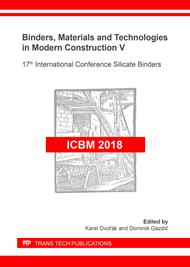p.131
p.137
p.143
p.149
p.155
p.161
p.167
p.173
p.180
Development of the HVFAC Modulus of Elasticity
Abstract:
Concretes with high fly ash content are within a unified world nomenclature often referred to as HVFAC, resp. high volume fly ash concrete. These concretes are characterized by the percentage of fly ash as an active admixture relative to a cement dose of at least in a ratio of 1:1. The use of these concretes falls into the field of construction with the necessary reduction in the development of hydration heat. In the experiment, long-term monitoring of the development of important mechanical parameters, namely the static modulus of compressive elasticity and compressive strength, was performed. Both monitored parameters play a very important role in the design of buildings, for which construction is HVFAC often used. These parameters were monitored within the carried out research until the time of 360 days. The results of the experiment give an overview of the pozzolanic reaction progress over the in the long-term time horizon and its impact on the concrete parameters monitored. The results clearly show that even after 360 days the development of the strength parameters of these concretes is not stopped.
Info:
Periodical:
Pages:
155-160
Citation:
Online since:
August 2019
Authors:
Keywords:
Price:
Сopyright:
© 2019 Trans Tech Publications Ltd. All Rights Reserved
Share:
Citation:


